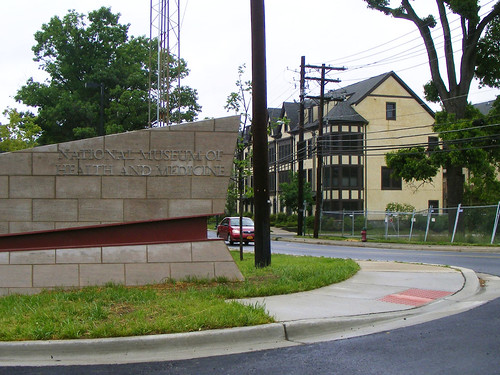
Yes, there's a photograph of a Civil War soldier who lost his chin, the preserved leg of a young man who had elephantitis, and a series of fetal skeletons. But they're presented to teach, not to shock like some other local museums.
"It's all about distance," says Tim Clarke Jr., deputy director of communications for the museum and a Silver Spring resident. He notes that "you learn a lot" from examining these artifacts. "Individually [they're] interesting," he says, "but as an aggregate, you learn about the disease."
The Army Medical Museum was founded in 1862 with a collection of "specimens of morbid anatomy" from the Civil War. Since renamed the National Museum of Health and Medicine, it has been located at Walter Reed Hospital in the District since the 1970's. When the BRAC Commission moved the hospital to Bethesda in 2005, the museum went to the Walter Reed Annex instead.
The new museum, designed by Philadelphia-based architecture firm KlingStubbins, was completed last summer and opened briefly with some temporary exhibits before the interior was finished.

Much of the collection is kept within the museum itself; the storage facilities and labs can be seen from the exhibition halls, allowing visitors a glimpse of other artifacts and ongoing research.
While the exhibits are designed to be flexible and change over time, some may be permanent, like the "Advances in Military Medicine" exhibit. That one includes the preserved floor of the trauma unit of a tent hospital in Balad, Iraq, pockmarked with gurney legs and stained with antiseptic chemicals and blood. Despite being a semi-temporary structure, the hospital had a 98 percent survival rate, says Clarke, who calls it the "floor where most American lives were saved" during the Iraq War.
The floor was displayed when the museum was still located at Walter Reed Hospital, where many veterans were recuperating. "They'd bring their mom, or their wife and kids," says Clarke, "and say, 'This is where I got my life back.'"
That's the real takeaway of the National Museum of Health and Medicine: not just a gigantic foot in a jar, but the ongoing progress of medical innovation, saving American lives here and abroad. And that's definitely nothing to be afraid of.
The museum is located at 2500 Linden Lane in Forest Glen and is open daily. Admission is free. Their website is a little out of date, so you might want to call 301/319-3300 for any further information.
The museum also wants to get out into the community, hosting free "Science Cafés" where residents can hear from scientists about the latest research. Their next Science Café, with Dr. Gillian Hooker of the National Human Genome Research Institute, is at 6pm tonight at the Silver Spring Civic Building on Ellsworth Drive.

3 comments:
Dan, your "contact me" address doesnt' work so I'm posting as a comment here. Did you know that last week the MoCo hearing examiner issued her report on the Chelsea School rezoning application? She recommends approval of rezoning the site to RT-12.5. So now the full planning board has approved it, the hearing examiner has approved it and as you know, all that's left is for the council to approve it. I know you've blogged before about this hyper local issue (as have others like Sligo at Silver Spring Singular). Hopefully you'll do an update based on this news (it's fantastic news for me since I'm a neighbor of the site and a big supporter of the EYA development).
David, I'd like to hear more. Can you shoot me an e-mail at justupthepike at gmail dot com? Thanks!
Everything you need can be found in the hearing examiner's recommendation to the council
http://www.montgomerycountymd.gov/content/council/zah/pdf/2012_Reports/G-892-Remand.pdf
In a nutshell, they accomplished what the hearing examiner required in the remand and reduced the # units, increased the green space around the historic site and overall site perimeter, and re-worked the internal drive.
Of course in the last session before the hearing examiner, SOECA completely rejected every single accomodation made by EYA. Not surprised, they only want single family detached homes on that site. Thankfully the hearing examiner disagreed with them and hopefully the council will too.
Post a Comment